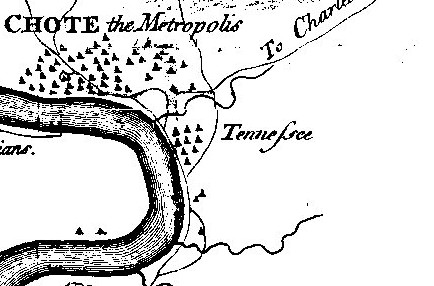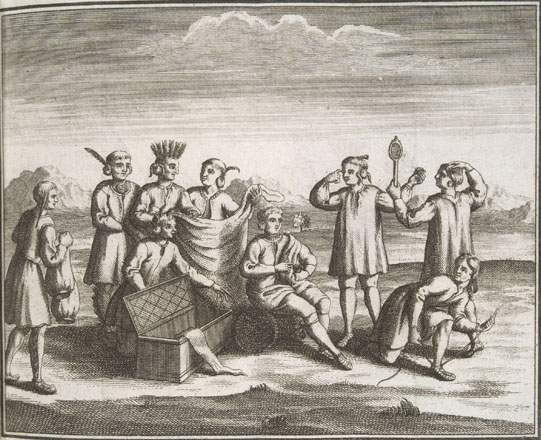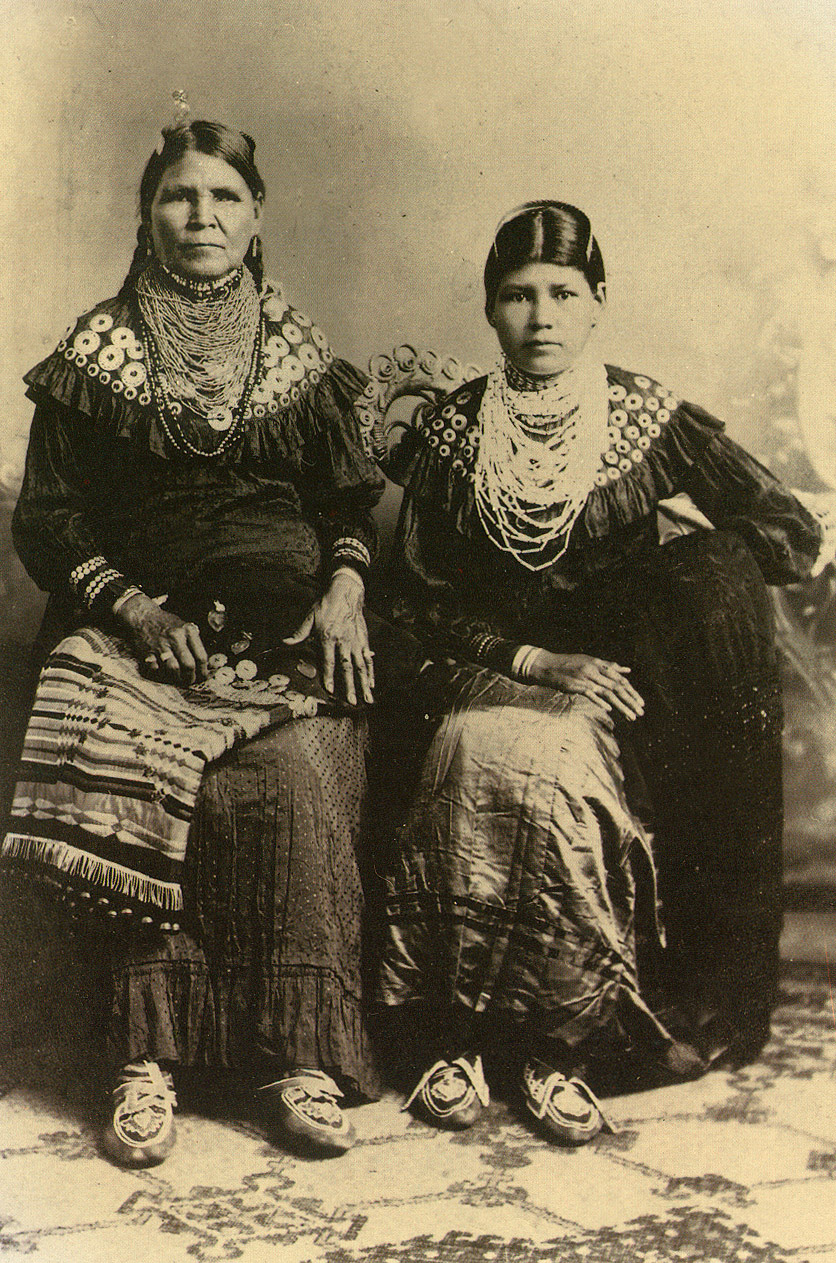|
Straight Tail Meaurroway Opessa
Straight Tail Meaurroway Opessa (c. 1630–1709), often referred to as Meaurroway, was Chief of the Pekowi, a subdivision of the Shawnee Native American tribe. He was also the Chief of the Turtle Clan, one of the most religious orders of the tribe. Biography Straight Tail was born in 1630 in present-day Ohio, to the Chief of the Pekowi and an unnamed Pekowi Woman (possibly Nimeeth Pekowi). Nothing is yet known of his childhood or teenage years, but he succeeded his father at the age of 40 in 1670, as both Pekowi Chief and Chief of the Turtle Clan. Each division of the Shawnee had control over different aspects of the whole tribe's lifestyle, and the Pekowi managed the Shawnee's state of order, duty and celebration of religion. As chief, Straight Tail was in charge of these important aspects of tribal life. Encounter with Martin Chartier In 1674 Straight Tail's band was living in a village on the Wabash River in what is now southern Illinois, where they were visited by French ex ... [...More Info...] [...Related Items...] OR: [Wikipedia] [Google] [Baidu] |
Tribal Chief
A tribal chief, chieftain, or headman is a leader of a tribe, tribal society or chiefdom. Tribal societies There is no definition for "tribe". The concept of tribe is a broadly applied concept, based on tribal concepts of societies of western Afroeurasia. Tribal societies are sometimes categorized as an intermediate stage between the band society of the Paleolithic stage and civilization with centralized, super-regional government based in Cities of the Ancient Near East, cities. Anthropologist Elman Service distinguishes two stages of tribal societies: simple societies organized by limited instances of social rank and prestige, and more stratified society, stratified societies led by chieftains or tribal kings (chiefdoms). Stratified tribal societies led by tribal kings are thought to have flourished from the Neolithic stage into the Iron Age, albeit in competition with Urban area, urban civilisations and empires beginning in the Bronze Age. In the case of tribal societies ... [...More Info...] [...Related Items...] OR: [Wikipedia] [Google] [Baidu] |
Tennessee
Tennessee (, ), officially the State of Tennessee, is a landlocked U.S. state, state in the Southeastern United States, Southeastern region of the United States. It borders Kentucky to the north, Virginia to the northeast, North Carolina to the east, Georgia (U.S. state), Georgia, Alabama, and Mississippi to the south, Arkansas to the southwest, and Missouri to the northwest. Tennessee is the List of U.S. states and territories by area, 36th-largest by area and the List of U.S. states and territories by population, 15th-most populous of the 50 states. According to the United States Census Bureau, the state's estimated population as of 2024 is 7.22 million. Tennessee is geographically, culturally, and legally divided into three Grand Divisions of Tennessee, Grand Divisions of East Tennessee, East, Middle Tennessee, Middle, and West Tennessee. Nashville, Tennessee, Nashville is the state's capital and largest city, and anchors its largest metropolitan area. Tennessee has dive ... [...More Info...] [...Related Items...] OR: [Wikipedia] [Google] [Baidu] |
Opessa Straight Tail
Opessa Straight Tail (), also known as Wopatha or Wapatha, was a Pekowi Shawnee Chief. He was the son of Straight Tail Meaurroway Opessa. He is best known for signing, on 23 April 1701, the "Articles of friendship and agreement between William Penn and the Susquehannah, Shawonah, and North Patomack Indians," that designated lands and conditions of coexistence between those tribes and the English settlers. Birth and early life His exact place of birth is unknown, but was most likely either Indiana or Illinois. He was living with his father in Illinois in 1674 when his village was visited by Louis Jolliet and later by René-Robert Cavelier, Sieur de La Salle, accompanied by Martin Chartier. In 1674 Chartier married Opessa's sister Sewatha Straight Tail (1660–1759). Chartier led a mutiny against La Salle in 1680 and became an outlaw, fleeing first to upstate New York, but later returning to live with Opessa's family at Starved Rock (later known as Fort St. Louis). Chartier retur ... [...More Info...] [...Related Items...] OR: [Wikipedia] [Google] [Baidu] |
Peter Chartier
Peter Chartier (c. 16901759) (Anglicized version of Pierre Chartier, sometimes written Chartiere, Chartiers, Shartee or Shortive) was a fur trader of mixed Shawnee and French parentage. Multilingual, he later became a leader and a band chief among the Pekowi Shawnee. As an early advocate for Native American civil rights, he joined other chiefs in opposing the sale and trade of alcohol in indigenous communities in the Province of Pennsylvania. He first tried to limit the sale of rum in Shawnee communities but also expanded that effort to other indigenous peoples. Because of conflict with the English provincial government, in 1745 he accepted a French commission and left Pennsylvania with his band. Beginning with more than 400 Pekowi Shawnee, he migrated over the next four years through parts of modern Ohio, Kentucky, Alabama and Tennessee. He and his people eventually resettled in the Illinois Country of New France, near a French colonial community. He and some of his warrior ... [...More Info...] [...Related Items...] OR: [Wikipedia] [Google] [Baidu] |
John Evans (Pennsylvania Governor)
John Evans may refer to: Academics *John Evans (archaeologist) (1823–1908), English archaeologist and geologist * John Evans (topographical writer) (1768–c. 1812), writer on Wales * John Cayo Evans (1879–1958), Welsh mathematician * John Davies Evans (1925–2011), English archaeologist * John Gwenogvryn Evans (1852–1930), Welsh minister and paleographer * John Robert Evans (1929–2015), Canadian cardiologist and civic leader * John V. Evans (astronomer) (born 1933), British-American * John Wainwright Evans (1909–1999), solar astronomer * John William Evans (geologist) (1857–1930), British * John William Evans (entomologist) (1906–1990), British entomologist Entertainment * John Evans (actor) (1693–1734), Irish * John Evans (19th-century writer) (died 1832), English writer * John Evans (artist) (1932–2012), American * John Evans (director), American film director and screenwriter * John Evans (special effects), on five James Bond films * John Bryan Evans (born 1 ... [...More Info...] [...Related Items...] OR: [Wikipedia] [Google] [Baidu] |
William Penn
William Penn ( – ) was an English writer, religious thinker, and influential Quakers, Quaker who founded the Province of Pennsylvania during the British colonization of the Americas, British colonial era. An advocate of democracy and religious freedom, Penn was known for his amicable relations and successful treaties with the Lenape Native Americans who had resided in present-day Pennsylvania prior to European settlements in the state. Penn also owned at least twelve enslaved people at his Pennbury estate. In 1681, Charles II of England, King Charles II granted an area of land corresponding to the present-day U.S. states of Pennsylvania and Delaware to Penn to offset debts he owed Penn's father, the admiral and politician William Penn (Royal Navy officer), Sir William Penn. The following year, Penn left England and sailed up Delaware Bay and the Delaware River, where he founded Philadelphia on the river's western bank. Penn's Quaker government was not viewed favourably by th ... [...More Info...] [...Related Items...] OR: [Wikipedia] [Google] [Baidu] |
Lenape
The Lenape (, , ; ), also called the Lenni Lenape and Delaware people, are an Indigenous peoples of the Northeastern Woodlands, Indigenous people of the Northeastern Woodlands, who live in the United States and Canada. The Lenape's historical territory included present-day northeastern Delaware, all of New Jersey, the eastern Pennsylvania regions of the Lehigh Valley and Northeastern Pennsylvania, and New York Bay, western Long Island, and the lower Hudson Valley in New York (state), New York state. Today communities are based in Oklahoma, Wisconsin, and Ontario. During the last decades of the 18th century, European settlers and the effects of the American Revolutionary War displaced most Lenape from their homelands and pushed them north and west. In the 1860s, under the Indian removal policy, the Federal government of the United States, U.S. federal government relocated most Lenape remaining in the Eastern United States to the Indian Territory and surrounding regions. The la ... [...More Info...] [...Related Items...] OR: [Wikipedia] [Google] [Baidu] |
Susquehannocks
The Susquehannock, also known as the Conestoga, Minquas, and Andaste, were an Iroquoian people who lived in the lower Susquehanna River watershed in what is now Pennsylvania. Their name means “people of the muddy river.” The Susquehannock were first described by John Smith, who explored the upper reaches of the Chesapeake Bay in 1608. The Susquehannocks were active in the fur trade and established close trading relationships with Virginia, New Sweden, and New Netherland. They were in conflict with Maryland until a treaty was negotiated in 1652, and were the target of intermittent attacks by the Haudenosaunee (Iroquois). By the 1670s, their population had declined sharply as a result of disease and war. The Susquehannock abandoned their town on the Susquehanna River and moved south into Maryland. They erected a palisaded village on Piscataway Creek, but in September 1675, the Susquehannock were besieged by militias from Maryland and Virginia. The survivors of the siege scat ... [...More Info...] [...Related Items...] OR: [Wikipedia] [Google] [Baidu] |
Nathaniel Blakiston
Colonel Nathaniel Blakiston was the 8th Royal Governor of Maryland from 1698 to 1702. He succeeded Francis Nicholson and was succeeded by Thomas Tench. He was related to Nehemiah Blakiston. Military career Nathaniel Blakiston was grandson of John Blakiston, regicide of King Charles I of England. Blakiston joined the British Army and served in the West Indies.The history of Parliament Posted by . As a soldier, Blakiston attained the rank of [...More Info...] [...Related Items...] OR: [Wikipedia] [Google] [Baidu] |
John Hansson Steelman
John Hansson Steelman, also known as "Hance" Stillman, Stelman, Tilghman, or Tillmann (1655–1749), the eldest son of Hans Månsson and Ella Olofsdotter Stille. He was a fur trader and interpreter who traded with Shawnee, Susquehannock and Piscataway people, Piscataway Indians in Maryland and Pennsylvania. Steelman made substantial donations to support the construction of the Holy Trinity Church (Old Swedes) Church, probably covering as much as a third of the building costs. He died in 1749 in Adams County, Pennsylvania at the age of 94. Birth and parents Steelman was born to Hans Månsson (1612-1691) from Skara Municipality in Sweden. His father served as a cavalryman in the Västgöta Regiment during the Thirty Years' War, 1638-1640, and came to New Sweden in 1641 as a criminal after being convicted of cutting down eight trees in the Royal Garden at the Varnhem Abbey which was owned by the House of Vasa, Swedish Royal family. After serving six years on a tobacco plantation, ... [...More Info...] [...Related Items...] OR: [Wikipedia] [Google] [Baidu] |
Lancaster County, Pennsylvania
Lancaster County (; ), sometimes nicknamed the Garden Spot of America or Pennsylvania Dutch Country, is a County (United States), county in the Commonwealth (U.S. state), Commonwealth of Pennsylvania, United States. As of the 2020 United States census, 2020 census, the population was 552,984, making it Pennsylvania's sixth-most populous county. Its county seat is also Lancaster, Pennsylvania, Lancaster. Lancaster County comprises the Lancaster metropolitan statistical area. Lancaster County is a tourist destination with its Amish community being a major attraction. The ancestors of the Amish began to immigrant, immigrate to colonial Pennsylvania in the early 18th century to take advantage of the freedom of religion, religious freedom offered by William Penn, as well as the area's rich soil and mild climate. They were joined by French Huguenots fleeing the Edict of Fontainebleau, religious persecution of Louis XIV. There were also significant numbers of English, Welsh and Ulster S ... [...More Info...] [...Related Items...] OR: [Wikipedia] [Google] [Baidu] |
Cecil County, Maryland
Cecil County is a county located in the U.S. state of Maryland at the northeastern corner of the state, bordering both Pennsylvania and Delaware. As of the 2020 United States census, the population was 103,725. The county seat is Elkton. The county is part of the Mid-Eastern Shore region of the state. The county was named for Cecil Calvert, 2nd Baron Baltimore (1605–1675), the first Proprietary Governor of the Province (colony) of Maryland. With the eastern part of the county closer to Philadelphia than Baltimore, it is part of the Philadelphia–Camden–Wilmington, PA–NJ–DE–MD Metropolitan Statistical Area. The county is located in Wilmington's Radio Market and Baltimore's Designated Market Area. History Colonial era The area now known as Cecil County was an important trading center long before the county's official organization in 1674 by proclamation of Lord Baltimore. It had previously been a northeastern part of a much larger Baltimore County, Mary ... [...More Info...] [...Related Items...] OR: [Wikipedia] [Google] [Baidu] |







